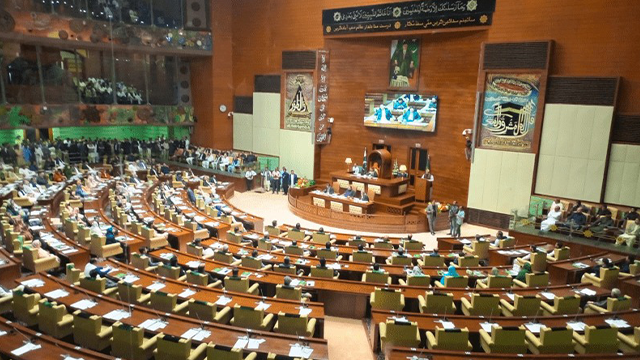10-year-old Farhad* manoeuvres his way through the tables laid around a small tea kiosk, where he works, at one of Karachi’s busiest streets flanking II Chundrigar Road.
“Chotay do dudh pat’ti [hey child, fetch two teas],” a middle-aged man shouts at Farhad, and the young boy rushes to the stove, where 15-year-old Arsalan* prepares tea.
After serving the tea, the man hands Farhad a Rs500 note and he delves into the pocket of his brown rags barely qualifying as Kameez Shalwar for change. He pulls out a bundle of notes and hands back the change. This simple mathematics has become second nature to this young tea seller, who has been roaming the streets of Karachi for the last three years.
Farhad has no time to go to school or even play. His day starts at 5am. He eats fried egg with lacha paratha which his mother cooks for him for breakfast. He makes his way to the tea shop as early as 6am on his small bicycle.
At around 12pm, he takes a break, eats whatever is cooked in the teashop and gets back to work by 12:30pm. His work hours span more than 12 hours. At around 8pm, his shift ends and he takes back home some Rs1000 along with tips he gathers throughout the day.
By the time he reaches home, he has no energy to play or watch TV. His mother cooks him dinner. The moment his cheeks touch his pillow, he falls asleep.
Children working at the kiosks are forced into these gruelling hours by their employers.
“My shift routine spans about 13 hours daily, a deviation within which may mean punishing measures from the kiosk owner,” Farhad told The Times of Karachi.
The menace of child labour in Pakistan is a serious issue. According to the United Nations Children Funds (UNICEF), about 3.3 million Pakistani children are subjected to child labour.
Another study conducted by NGO, the Society for the Protection of the Rights of the Child (SPARC), held that 8 million children were engaged in forced labour in Pakistan. However, it is likely that the numbers are much higher.
Child labour has far-reaching consequences for children, depriving them of their entire childhood from a lack of access to education to often lifelong physical and mental health problems.
The Chairman of the Sindh Mental Health Authority, Senator Dr Karim Ahmed Khuwaja, who is also a psychiatrist, told Times of Karachi that children need love and affection from parents which child labour deprives them of. The mental health authority was formed by the provincial government, to implement the Sindh Mental Health Authority act, 2013.
“If you deprive them of such love and bind them with strict working hours, mental wellbeing will definitely be compromised,” Khuwaja said. “Children can also be [physically and emotionally] abused in child labour, which can cause these children to be traumatized for the rest of their lives. Child labour negatively affects child development.”
He also stressed that children forced into child labour can find themselves engaged in criminal activities. “They seek to escape from their work and then criminal gangs become a solace for them.”
Clinical psychologist Khan Afridi told TOK that until the age of seven “Children should not be sent to schools, let alone made to work at teashops”. This, he says, is no less than a “crucible for his chronic post-traumatic stress disorder”.
“Labor like this is a huge responsibility which these children are not naturally built for. Confining them into strict working hours is tantamount to clipping their wings forever,” he said.
At such a young age they need to explore the world around them, he stressed. Afridi added that conditioning children to industrious lives during their formative years when they should be loved and educated is an affliction beyond measure.
“Children forced into labour can suffer from diabetes as early as in their twenties,” Afridi said. “They are likely to end up with blood pressure and anxiety issues in their thirties as they are living under constant stress. Our society breaks their resilience and shatters their dreams.”
Farhad lives in a three-room apartment near City Station. There’s a broken window covered with scruffy curtains, from which kittens make their way in and out of the house. There’s an old TV in the lounge, the carpet is faded and the furniture is plain.
Children like Farhad provide an income source for their families often living in extreme poverty and fighting for their survival.
Farhad originally comes from Quetta. He misses being in the valley, where he recalls playing with all his friends and cousins in the narrow alleys of the Northern Balochistan city. He would enjoy games of hide and seek in the summer and play in the snow in winter. “We left all the fun back in Quetta. Here we just work day and night,” Farhad said.
Farhad has seven siblings and he is the third oldest of the children. “All my brothers work, while the sisters stay at home,” he said. A few of his brothers work at a puncture shop in Sharae Faisal.
Farhad’s father is in his forties and was forced into marriage when he was 18-years-old to one of his cousins. “Each son of mine earns no less than Rs1200 a day,” he said, adding that the entire family brought home an estimated Rs7000 to Rs8000 and sometimes even more than Rs10,000 every day, which he said amounted to a significant sum of money by the end of the month. “We can easily pay off our house rent, and utility bills and make ends meet,” his father said.
Discussing the issue of his children attending school, his father said, “What difference will it make if they start going to school? There aren’t jobs for those who study. We are better off this way.”
Rana Asif Habib, a lawyer and the president of the Initiator Human Development Foundation, an NGO working towards improving the lives of street children, said an estimated 6.2 million children were not attending school in Sindh alone. “Parents have children so that they can become a source of income for the family,” Habib said.
In Karachi, half a million children find themselves begging on the streets. Begging hotspots include Hyderi, Burns Road, Boat Basin, outside hospitals and at different traffic signals: all the places where footfall is dense. “There are Afghani children who are involved in begging, for which we have no data,” Habib said, “Approximately 100,000 children are involved in shoe polishing businesses or they work at different restaurants or tea shops.”
Burmese and Bengali children in the area are also affected. “They are involved in the fish cleaning business. But there’s no data available. Again, there is also no data available on how many children work in the agriculture sector, either,” Habib said.
Sindh labour laws currently allow children under 14-years-of-age and those between 14 and 18-years-old to work under certain conditions. A government official working in the children’s welfare department told the Times of Karachi on condition of anonymity that there were certain laws in place that safeguard children from child labour but that those laws were rarely implemented.
The first and only National Child Labor Survey (NCLS), was carried out in the year 1996 in Pakistan, by the International Labor Organization (ILO), which held that 3.3 million children were engaged in child labour. Habib said the Sindh government was supposed to produce child labour data for 2019, but three years later this data has yet to be published.
Federal Human Rights Minister Shireen Mazari said the government organization has long campaigned to eradicate child labour. “We also urge parents and onlookers to report anything to the relevant offices, when observed.”
*The name of the child in the story has been changed to protect his identity.





